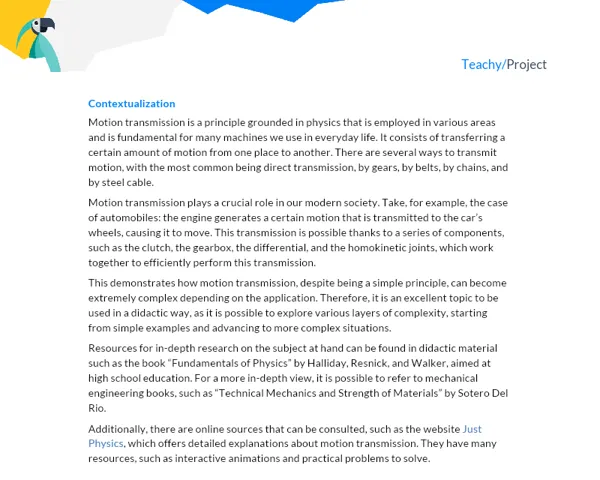Introduction
Power is a fundamental concept in physics, with significant relevance in various areas of science and engineering. Commonly associated with energy, power is actually a measure of the amount of work done or energy converted per unit of time. In simple terms, it indicates how quickly work is done or energy is transformed.
In Physics, power (P) is defined as the amount of work (W) done or the amount of energy (E) transferred or converted per unit of time (t). Its formula is: P = W/t or P = E/t. The unit of measurement for power in the International System of Units (SI) is the watt (W), which corresponds to the work of one joule done in one second.
In addition to these basic concepts, to truly understand power, we also need to understand the relationship between work and energy. Work is the measure of energy transferred by applying a force over a distance. While energy is the capacity that a physical system has to do work.
Context
Power is a widely applied concept, both in daily applications and in scientific and industrial contexts. In everyday life, we find clear examples of its utility when analyzing and comparing the performance of different household appliances or vehicles - the higher the power of a car, the faster it can accelerate; the same goes for the performance of an oven, whose power will determine the time needed to cook a food item.
From an industrial and scientific perspective, power is a crucial factor in the development of new technologies, such as more efficient engines for automobiles, aircraft, and electrical equipment. It is also used in various engineering applications, such as calculating the energy efficiency of buildings, power plants, and electrical circuits.
For further exploration on the topic, we suggest the following resources:
- Book "Physics for Scientists and Engineers" by Paul A. Tipler and Gene Mosca. Chapter 6, "Work and Energy".
- Khan Academy: Power
- IFSC: Physics - Electric Power
- Video Physics - Energy and Power from the Interactive Physics YouTube Channel.
Practical Activity
Activity Title: Power Analysis in Common Household Appliances
Project Objective
To study the concept of power by calculating the power used by different common electrical appliances in a household, such as a hairdryer, a microwave, a refrigerator, a TV, among others.
Detailed Project Description
In this project, students should select at least three common electrical appliances. They should gather information about the energy consumption of these appliances (usually available in manuals or energy efficiency labels) and calculate the power of each.
They should also investigate and discuss how power affects the performance and energy consumption of the appliances. This will allow students to practically understand a complex theoretical concept and the relationship between work and energy.
Required Materials
- Common electrical appliances (hairdryer, microwave, refrigerator, TV, etc)
- Manuals of the appliances or reliable online sources to find energy consumption data
- Calculator
Step-by-Step Guide for the Activity
- Form groups of 3 to 5 students.
- Select the electrical appliances to be studied.
- Research and collect the energy consumption data of the selected appliances.
- Calculate the power of the appliances using the formula P = E/t, where E is the consumed energy (in kilowatt-hours) and t is the usage time (in hours).
- Analyze and discuss the results obtained, comparing the power of the different appliances and investigating how power affects their performance and energy consumption.
- Prepare a detailed report containing the research results and analysis, as explained below.
Project Deliverables
As a result of the project, each group should prepare and submit a written report, with the following elements:
Introduction:
They should explain the concept of power used in physics and the relevance of this quantity in everyday life. They should also mention the appliances they chose for the study and the reason for their choices.
Development:
Here, students should detail the methodology used to calculate power and present the results obtained. They should also discuss these results in terms of the appliances' performance and energy consumption, thus illustrating the practical application of the power concept.
Conclusion:
Students should summarize the main points of the project and the lessons learned. They should discuss how understanding power can help them use household appliances more efficiently and consciously.
Bibliography:
Students should list the sources of information used in the project, such as appliance manuals, manufacturer websites, physics learning resources, etc.
This project should be carried out over a month, with each student contributing a total of 5 to 10 hours of work. The final report should be presented in a class meeting, where groups will have the opportunity to share their findings and discuss their conclusions with classmates and the teacher.


